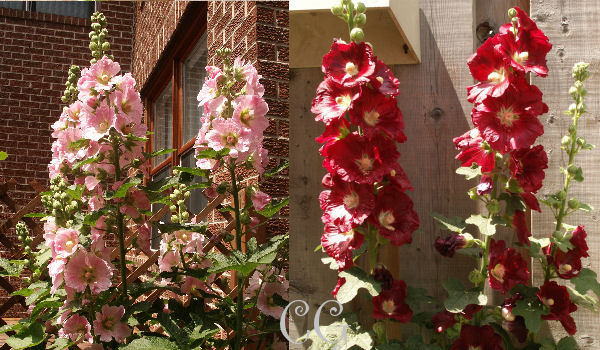Growing Biennial/Perennial Hollyhocks
in Canada

Growing Hollyhocks in Canada Zone3-8 :
Gardeners are always looking for vertical height in their garden. We either use
hardscaping or plants. I use whatever I can find, but mostly flowers, plants, trellises
or trees. I have been growing Hollyhocks for years, but lately I'm struggling with
Hollyhock Weevil Beetle and Rust. However, I hear there's rust resistant Hollyhocks
available. Check the seedpacket before you buy. :)
Hollyhocks prefer well drained, moist soil and full sun.
Hollyhock Black Weevil Beetle:
I start in early spring cultivating the area around the Hollyhocks, add some compost and
spray with garlic spray and oil to deter the Hollyhock's Weevils.
If I get desperate I use store bought insect spray or just handpick them.
For Rust on the leaves:
I just spray the leaves with baking soda and water. 1 litre of water and 1 tablespoon
baking soda.
Will Hollyhocks come back next year?
Hollyhocks is a hardy Biennial plant in Zone6. They will grow a rosette of leaves the first year and bloom the second year. However, in my Zone Hollyhocks behaves like a perennial with lots of seedlings every where and the cycle continues the next year. In the fall I cut the dry stalks back and mulch well. You will get more flowers with new plants every year. Nature will do the sowing for you and it's always right.
Growing Hollyhocks from Seed?
I only grow
Hollyhocks from Seeds .
They self-seed for me as well, but I save seeds from my favourites, before they drop
seeds everywhere. You can buy hollyhock seeds from McKenzie
Seeds.
Just a happy customer.
Went to check their website and hollyhocks are out of stock. Most stores carry
Hollyhocks, though.
What time of the year do you plant Hollyhocks?
I like to transplant or plant Hollyhocks
in the spring.
A large of clump of Hollyhocks in the garden is great for Wildlife. Hummingbirds,
Dragonflies and Butterflies love them.
Growing Hollyhock Advice
Growing Hollyhocks
Biennial vs. Perennial: Hollyhocks are typically biennial, meaning they grow leaves in the first year and flower in the second. However, after hollyhock plant is established some varieties act more like perennials, producing flowers each year. Rust Resistance: Look for varieties that are resistant to rust, a common disease that affects hollyhocks and turn the leaves brown spotted instead of the pretty dark green.
Planting Location:
Sunlight: Full sun. Aim for at least 6 hours of direct sunlight per day.
Soil: Well-drained soil that is rich in organic matter. Amend heavy or clay soils
with compost to improve drainage.
Hollyhocks Planting Tips:
Timing: Sow seeds in early spring or late summer outside. You can also start
seeds indoors 6-8 weeks before the last frost date and transplant seedlings outdoors. I
like just sprinkling the seeds outside in the spring and after that the plants spreads
it's own seed to perfection.
Spacing: Space plants about 12-18 inches apart to allow for their tall growth and
airflow between plants. I usually plant hollyhocks in clumps where I need height.
Care and Maintenance:
Watering: Hollyhocks are relatively drought-tolerant once established, but will
perform better with regular watering.
Fertilizing: I apply a balanced fertilizer once a year in early spring.
Over-fertilizing can lead to excessive foliage growth.
Pest and Disease Management:
Pests: The hollyhock weevil. Use insecticidal soap, neem oil or when I have
enough - I buy "Garden Raid".
Disease: Rust is a common problem. To manage it, provide good air circulation,
avoid overhead watering, and remove infected leaves. Consider using rust-resistant
varieties if you've had problems in the past. I use a litre of water with 1 tablespoon
of baking soda. Rust won't hurt the plant. Weevils on the other hand will eat the
hollyhock buds.
Staking and Support:
Staking: Due to their tall growth, hollyhocks may need staking to prevent them from falling over. I like tomato cages for tall floppy plants, however hollyhocks are not a problem for me. They seem to hold their own weight.
Winter Care:
Mulching: Apply mulch around the base of the plants in fall to help protect the roots from winter cold and say " I will see you next year!". :)
Propagation:
Seed Saving: Hollyhocks self-seed readily. Collect seeds from mature plants in the
fall and store them in a cool, dry place for planting next season or share your bounty
with friends. Hollyhocks will bless you with lots of seeds.
Division: If I need extra plants, I find division easier. I just use a spade and
cut the hollyhock clump in pieces. Usually in half.
Design Tips:
Planting Design: Hollyhocks can be used as a dramatic backdrop in garden beds. When they are in bloom they do demand attention. They pair well with other tall plants like delphiniums and lupins.
Troubleshooting:
Reduced Blooming: This can occur if plants are over-fertilized or not given enough sunlight. For me it's usually not enough sunlight.
Grow Flowers ||
Perennial Gardening
||
What's
Blooming this Month ||
Garden Content
Growing Flowers
Table of Contents
Canadian Gardening
- more Reading
- Perennial Gardening
- Growing Food
- Growing Herbs
- Gardening for Birds
- Landscaping for Butterflies
- Landscaping for Hummingbirds
- Spring Bulbs - Tubers - Corms
- Container Gardening
- Flower Gardening
- Gifts from the garden
- Homemade Pesticide & Herbicide
- Seed Packet Templates
- Seeds - Harvesting, Drying & Storing
- Infusing Oils & Vinegars
- Printable Templates
- Photo Gallery